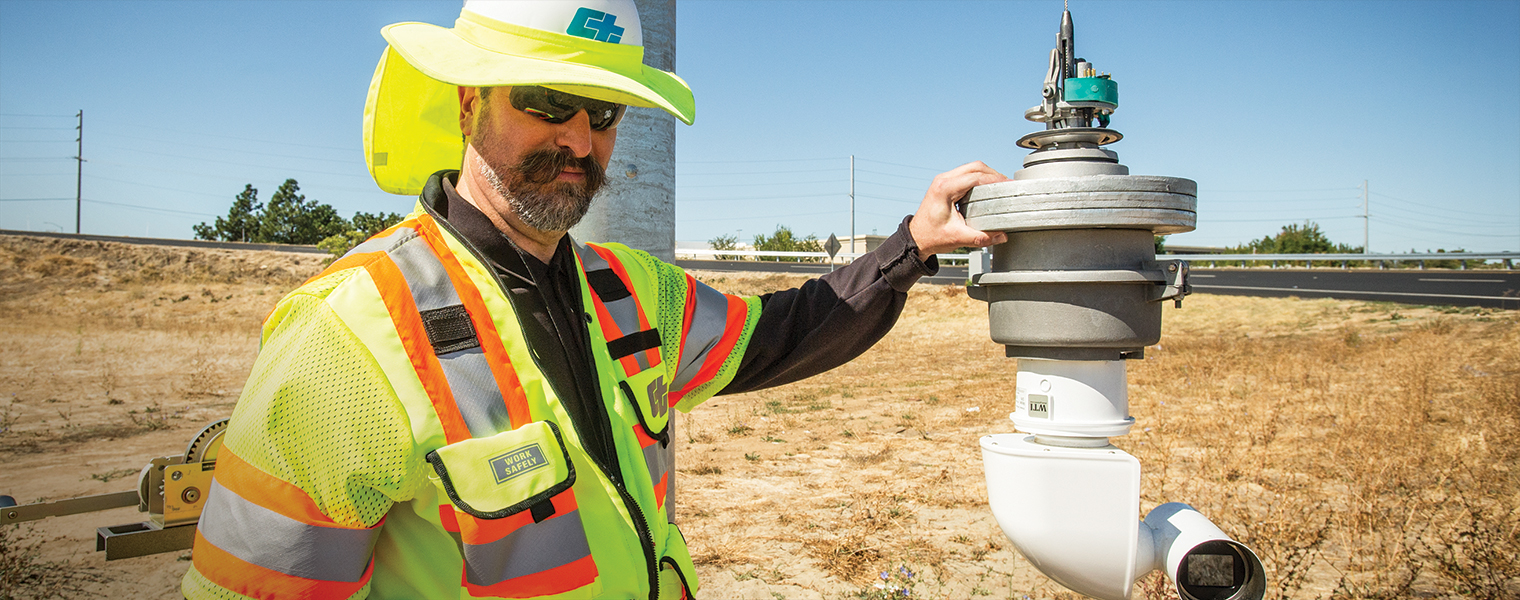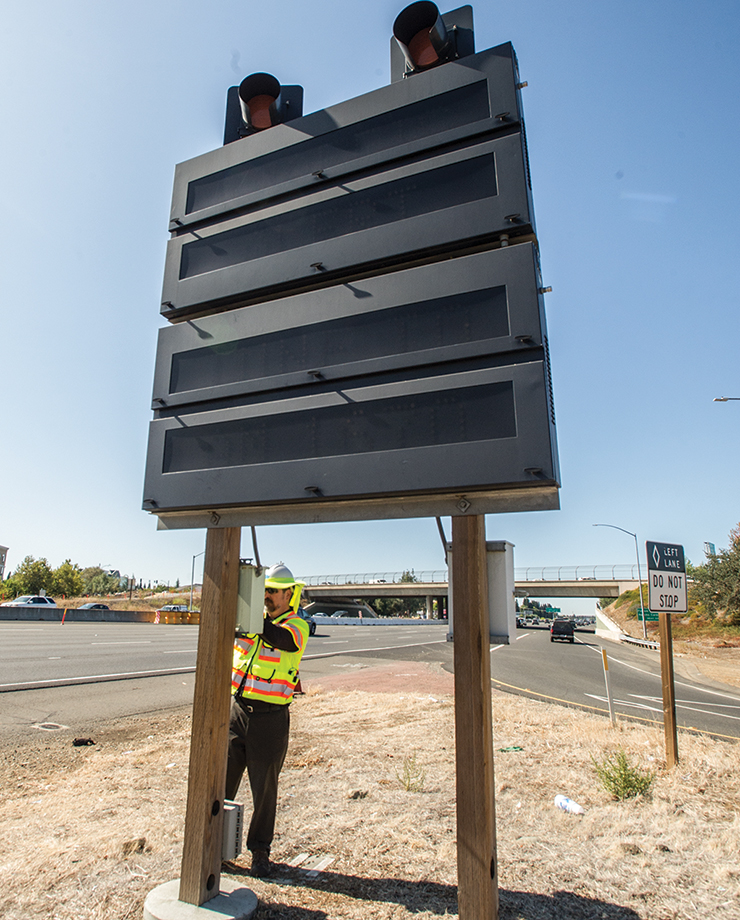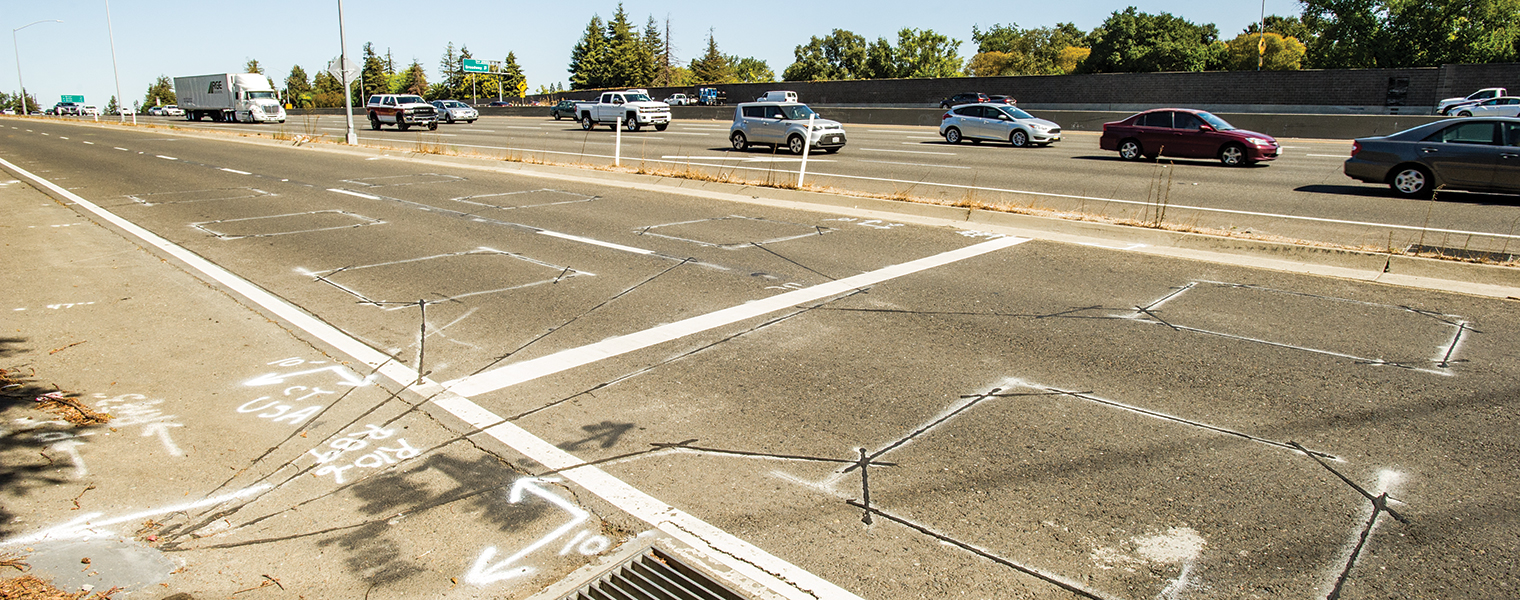‘Signals, Signs and Sensors’ High on Fix-It List
Function of Vast Highway Network Tied to Transportation Management Systems

Largely unseen by travelers, Caltrans maintains a massive, interconnected grid of electrical devices and hardware that reduce highway user delays, provide real-time information about traffic conditions, and collect information on traffic behavior to help forecast trends and plan projects.
These components make up Caltrans’ Transportation Management Systems, performing critical functions that help the Department keep people, vehicles and goods moving. Known as TMS for short, these systems have been designated as one of the four priority areas of highway operations that are receiving money through the Road Repair and Accountability Act of 2017 (Senate Bill 1).
Under SB 1, Caltrans is responsible for repairing or replacing about 7,700 signals, signs and sensors in its TMS system by 2027. “Signals, signs, and sensors” is SB 1 shorthand for all nine TMS element types, which are closed circuit televisions, changeable message signs, traffic monitoring detection stations, highway advisory radios, freeway ramp meters, roadway weather information systems, traffic signals, traffic census stations, and extinguishable message signs. Completing those fixes in the next eight years will help achieve the 90 percent good condition goal for TMS equipment required by the new law.
It’s a high bar, considering the complexity of the system and the amount of work required, but Caltrans has been making steady progress toward improving the program in just a few years since SB 1’s passage. The strategy to bring Caltrans’ TMS units into a state of 90 percent good condition involves managing the functional uptime and life cycle condition of TMS units.
According to an August 2019 performance report compiled by Caltrans’ Division of Traffic Operations, more than 67 percent of all TMS types on average are in good condition, while 33 percent are in poor condition (either beyond expected life cycle or have failed uptime criteria). While 74 percent of Caltrans’ freeway detectors were working and classified in good condition, the statewide network of ramp meters was performing better overall, with 79 percent in good condition. Meanwhile, the inventory of changeable message signs is meeting performance targets with 90 percent in good condition.
To meet the double challenge of keeping these systems in good condition and optimally performing through their life cycle, the Department’s Divisions of Traffic Operations and Maintenance realigned their roles so that Traffic Operations can focus on improving life cycle condition, while Maintenance can address functional uptime performance. The change in TMS management structure within Caltrans is expected to yield program benefits.
Traffic Operations engineers are responsible for establishing TMS operational and technology standards, asset management and life cycle replacement, installation or commissioning of new locations, and operation of the TMS infrastructure. Maintenance engineers oversee proactive monitoring and system health checks, asset inventory, troubleshooting and repair, minor equipment replacement and service restoration for TMS field elements and related communications systems. Maintenance engineering teams have become more proficient at monitoring true system performance by flagging TMS units that are in construction zones and vulnerable to disruptions. Those engineers are now focused on developing more proactive measures to stay ahead of functional problems. Not taking life cycle age into account, 75 percent of traffic monitoring detection stations are functioning with acceptable uptime while overall TMS uptime is at 89 percent.

Thousands of components working together
Today's systems, subsystems and individual units often are highly interdependent, meaning that a single malfunction can critically impair intended traffic operations. Information from those sources is relayed via fiber optic lines and leased network and wireless services to Caltrans’ transportation management centers, which serve as the nerve centers for highway operations throughout the state.
The field systems connect with a linked network of computer servers and communications software that allow real-time management of the vast state highway network, including complex integrated corridors such as those in the greater Los Angeles and San Francisco Bay areas that accommodate heavy flows of passenger and freight traffic.
Of the nine official categories of TMS units, traffic signals, traffic monitoring detection stations, and freeway ramp meters make up the majority. As of August 2019, the Caltrans TMS Inventory Database includes approximately 5,300 traffic signals, 5,000 detection stations (consisting of over 40,000 individual sensors), and 3,000 ramp meters that count and regulate traffic to as part of the operation of the State Highway System.
Traffic monitoring detection stations, using either in-pavement loop detectors or off-pavement radar, make up about 75 percent of Caltrans’ total TMS inventory and represent the largest challenge to keep functioning. These stations are used to monitor overall traffic movement, measure and report travel times, and harmonize traffic flow through advanced corridor and ramp metering systems. Vehicle detectors also allow traffic signals and freeway ramp meters to control the signal timing of traffic entering the highway intersections or freeway ramps. While all TMS units are equally susceptible to the impacts of wire theft, in-pavement loop detectors are the most vulnerable to damage due to construction activities since they are not easily visible.

Constant monitoring required
Monitoring a TMS system of the size and complexity of Caltrans’ is an enormous task, a far cry from the early 1970s when the first ramp meters were installed in the Los Angeles area. More than 80,000 preventive maintenance checks and repairs are performed annually to ensure maximum TMS operability. In addition to using its Division of Maintenance crews, Caltrans also utilizes on-call private service contracts for overflow work or repairs to more specialized parts of the TMS network, such as wireless units, fiber optic equipment, and communication hubs.
Caltrans primarily relies on an automated reporting system to track the condition of its traffic monitoring detection station infrastructure. The Performance Measurement System (PeMS) is a web-based system that displays traffic data on a map collected in real-time from more than 40,000 individual detectors. These sensors span the freeway systems across all major metropolitan areas of the state.
PeMS automatically generates reports on the health of the detector sensors, but other parts of the TMS system require visual inspections. Failures are logged into an overall reporting system that provides equipment uptime status.

Forecasting what parts might fail
For Caltrans, forecasting the expected life and functionality of TMS elements is key to improving the overall system and achieving SB 1 performance targets. However, developing deterioration rates or models for TMS units, particularly planning for electronic components that can suddenly fail without warning, is complex, and the technology is constantly changing. Overall life cycles for TMS units range from 10 to 25 years. More than 30 percent are operating beyond their expected life cycle.
Continuous investment in TMS infrastructure is required to maintain functionality by replacing and updating obsolete equipment, according to Caltrans’ 2019 State Highway System Management Plan. Thankfully, SB 1 revenues are delivering a much-needed boost to upgrade the system. The TMS program received $216 million in funding in 2019, more than double the $85 million allocated in 2015 prior to the passage of SB 1. This funding is focused on improving the health of traffic monitoring detection stations.
Technological improvements of individual components are expected to improve overall TMS performance, and collection methods also are expanding. Caltrans has traditionally relied on its TMS infrastructure to collect the necessary data to operate and monitor highways.
Recently, the Department has been exploring the option of purchasing traffic information from outside companies that collect data information through driver cellphone location or in-vehicle units to augment Caltrans’ traffic data. While purchased data can readily be used to provide overall travel times, it cannot deliver all traffic data needs where specific lane volumes and vehicle classifications are necessary. The future model will likely include a hybrid of purchased and physical infrastructure for detection purposes.
Caltrans is piloting the use of “purchased data” in three regional districts to obtain traffic information in more remote areas where the cost of installing conventional, hard-wired detection devices is prohibitive. The travel time data is stripped of any personal identifying elements and packaged to provide the contracted information. The trial use of this mode of traffic information shows promise for reducing the reliance on Caltrans’ TMS infrastructure in the future.
Areas of need identified, addressed
Outside analysis of the TMS program also helped zero in on ways to improve performance and identify problem areas that previously held up progress. A performance audit of the TMS program by Caltrans’ Independent Office of Audits and Investigations was conducted in the 2017-2018 fiscal year, and found that highway infrastructure components had not been accurately counted or catalogued at a district level. Without a reliable description of those TMS assets, auditors said, establishing an SB 1 performance baseline or future goals would be difficult.
TMS program managers implemented audit recommendations to update the number, type and condition of components in the TMS inventory and keep those counts current. Those improvements have been implemented, auditors noted earlier this year. Further work to provide more definitive guidance on project scope and treatment requirements to meet performance objectives is underway, which will improve the accuracy and integrity of the TMS asset management program — ensuring that SB 1 asset management goals and performance targets are met.

Source: Monica Kress, Deputy Chief (Mobility), Division of Traffic Operations, Stan Slavin, Transportation Management Systems Performance Strategy Manager, Division of Traffic Operations; Patrick Leung, Acting Chief, Office of Transportation Management Systems, Division of Traffic Operations; John L. Castro, Chief, Traffic Signals & Ramp Metering Branch, Division of Traffic Operations; Jas Bhullar, Chief, Office of Traffic Systems Maintenance, Division of Maintenance; Caltrans 2019 State Highway System Management Plan; Caltrans Independent Office of Audits and Investigations

